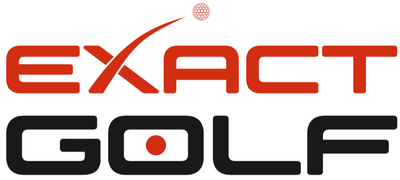Finding the right Lie for your irons
The Lie is not a simple subject and above all very individual. Much shows up only after several strokes on the course and it is not possible to determine the right lie with a few strokes - no matter if you use the best simulator or a so-called lie plate.
Before we go into detail first of all the concept of the Lie. The lie is measured in degrees and shows the angle of the shaft and the underside of the clubface. For a 6 iron, the lie is usually 61°. But it is not carved in stone and can be changed accordingly. At least with our irons at ExactGolf. This is one of the reasons why we only work with soft steel that can later be "bent". So you can change the lie by a few degrees at any time. And that is also important, because as already mentioned, the right lie is often only obtained in practice on the course and not in a club fitting.
Here you can see a typical toe down impact:
And here a club that is heel down:
The usual fitting practice is to have the player hit on a lie plate. Then you can see whether the club touches the toe or the heel. The idea is to adjust the lie so that the club is as straight as possible, i.e. has the lowest point in the middle. The idea is basically correct: if the club is placed in the middle, it will not twist at impact and the ball will fly straighter.
However, this is not automatically the case. At the end of the day it is about the ball flight and not about producing a straight and even divot. Nice divots don't result in lower scores automatically.
However, there are tendencies that already limit the selection. Players who tend to pull or hook should think about correcting the lie downwards. The clubface then tends to be more on the "toe-side" and counteracts this left tendency. If the clubface is "heel-sided" it's likely to close even more during impact - one would like to avoid exactly this however if one has a tendency to the left.
This is relatively rare and can only be observed with players whose hands are very deep in impact. It's rather very good players who tend to do so. All other players tend to do the opposite, i.e. having high hands in impact and the clubface tends to have the lowest point at the toe. This counteracts a left tendency and reduces the effect of the "closing face".
If you let this player hit on a lie plate you would clearly see that the lowest point is at the toe. The idea would then be to correct the lie upwards. But this can make the left tendency stronger. If somebody hits a straight ball even with "toe-sided" impact and you correct the lie it is possible that the player starts hooking. The adjustment was well meant but harms the player.

Another problem with Lie plates is that they have nothing to do with the grass surface. So they don't give any information about how the club interacts with the ground. So the plate can only give you an idea in which direction a player tends to go. If, for example, we have a player who tends to pull or hook and sees on the plate that the lowest point is "heel-sided", an adjustment is probably right. In this case you would correct the lie by 1 or 2 degrees downwards and the center of impact would move back towards the center. The left tendency is thus countered.
Of course the body size plays a role but it is also individual and nobody can say that you should take one Lie with 1.70m upward and another from 1.80m up. Of course a very big player with "normally long" arms will swing more "upright" and therefore needs an adjustment upwards. And a very small player will swing flatter and tends to touch the ground with the heel. In this case you would have to correct downwards.
However, even in a normal fitting it is difficult to determine what the correct lie is. In addition, the swing changes during the season and an adjustment of the lie becomes necessary. This makes it all the more important to use clubs that allow this change afterwards. You can order a set in spring that just has the perfect lie, but in the course of the season it turns out that the lie is suboptimal and should be adjusted. Would you like to buy a new set of clubs then?
Lie plates have their justification and give a good idea where the player is. But they cannot be decisive for the choice of the right read. At the end of the day it is crucial how the club face behaves on the grass surface and what the ball flight looks like. It's not about producing the most beautiful divots as possible - even if many fitters still think so.


